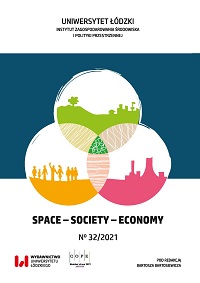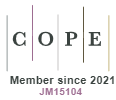How post-mining areas impact the spatial development and land use of cities. The case of the city of Łódź
DOI:
https://doi.org/10.18778/1733-3180.32.05Keywords:
post-mining areas, spatial development, land use, ŁódźAbstract
The growth of urban populations and the development of cities was typically accompanied by the use of specific construction materials. Their kinds depended mainly on the local resources, which is why many extraction sites were established in the immediate vicinity of cities. As settlements expanded, post-extraction areas were incorporated into city limits. Those areas have had a major impact also on the direction of development. The aim of this paper is to analyse post-mining areas located within the city limits of today’s Łódź, and to assess how they influenced the city’s spatial expansion and contemporary land utilisation. The textile industry boom in the city in the 19th century resulted in a population explosion, from 190 people in 1793 to 600,000 in 1914, i.e., an increase by over 3,000 times in just a century. That entailed an extraordinary demand for construction material. For one hundred years (from mid-19th to mid-20th century) buildings were predominantly constructed using brick fired from glacial till, which was abundant on the surface. That is why brickyards and related extensive pits were established at the city’s outskirts. Extraction pits established within the belt between the city’s 1840 and 1915 limits impacted the urban areas’ development the most. Clay pits, i.e., water-filled recesses, hindered development and the planned expansion of the urban area; they constituted local obstacles. Dense development emerged along routes which ran between the pits. Post-mining areas were the cause of the chaos in the urban planning within the area which was incorporated into Łódź at the turn of the 20th century (a fact which has been often discussed in literature). Even in the 1950s developments had to avoid numerous surviving clay pits. It was only in the latter half of the 20th century that decisions were made regarding their utilisation. In general, within Łódź’s urban area between the 1840 and 1915 city limits there are various green areas, which are intertwined with residential areas or industrial/warehouse sites.
The latter half of the 20th century saw the erection of high-rises made of the so-called large panels, the manufacturing of which require large amounts of sand. This material was also excavated within the city limits, though sand pits were predominantly located in the peripheries. Today, post-excavation areas are mostly occupied by green areas, fields, and wastelands. One could conclude that former post-mining (degraded) areas located within the city limits were assigned new value and they acquired new functions, including those particularly important for people’s lives, i.e., green and recreation areas. They are important for urban nature systems, especially now, when faced with climate change.
Downloads
References
Atlas miasta Łodzi, 2002, Liszewski S. (red.), Łódzkie Towarzystwo Naukowe, Łódź.
Google Scholar
Bald W., Jastrzębska E., 1984, Planowanie przestrzenne w PRL, „Miscellanea Łódzkie”, 1: 136–159.
Google Scholar
Brueckner J.K., 2000, Urban sprawl: diagnosis and remedies, „International Regional Science Review”, 23(2): 160–171. https://doi.org/10.1177/016001700761012710
Google Scholar
DOI: https://doi.org/10.1177/016001700761012710
Conzen M.R.G., 1960, Alnwick, Northumberland: a study in town-plan analysis. Transactions and Papers of Institute of British Geographers, 27. https://doi.org/10.2307/621094
Google Scholar
DOI: https://doi.org/10.2307/621094
Craig J.R., Vaughan D.J., Skinner, B.J., 2003, Zasoby Ziemi, Wydawnictwo Naukowe PWN, Warszawa.
Google Scholar
Czarnecki W., 1964, Planowanie miast i osiedli, tom VI, Region miasta, PWN, Warszawa–Poznań.
Google Scholar
Drzewiecki B., Pękacka-Falkowska K., 2012, Historia Parku Miejskiego w Toruniu (1817/1818–1939), Biblioteka Towarzystwa Miasta Torunia, Toruń.
Google Scholar
Fabiańska P., 2004, Problematyka terenów poeksploatacyjnych na obszarach miejskich i podmiejskich, [w:] J. Słodczyk (red.), Przemiany struktury przestrzennej miast w sferze funkcjonalnej i społecznej, Uniwersytet Opolski, Opole: 165–181.
Google Scholar
Flatt O., 1853, Opis miasta Łodzi pod względem historycznym, statystycznym i przemysłowym, Drukarnia Gazety Codziennej, Warszawa.
Google Scholar
Ginsbert A., 1962, Łódź, studium monograficzne, Wydawnictwo Łódzkie, Łódź.
Google Scholar
Górska-Zabielska M., Zabielski R., 2016, O możliwości rozwoju geoturystyki w Pruszkowie i okolicy, „Turystyka i Rekreacja – Studia i Prace”, 18: 27–39.
Google Scholar
Halicz A., 1988, Kultura fizyczna, [w:] B. Baranowski, J. Fijałek (red.), Łódź. Dzieje miasta, tom I, PWN, Warszawa–Łódź: 617–624.
Google Scholar
Jaskulski M., 1995, Stare fabryki Łodzi, Towarzystwo Przyjaciół nad Zabytkami, Oddział w Łodzi, ZORA. Łódź.
Google Scholar
Kobojek E., 2013, Environmental determinants of development and physiography of Łódź, [w:] M. Habrel, E. Kobojek (red.), Lviv and Łódź at the turn of 20th century, Wydawnictwo Uniwersytetu Łódzkiego, Łódź: 111–132.
Google Scholar
Koter M., 1988, Rozwój przestrzenny i zabudowa miasta, [w:] B. Baranowski, J. Fijałek, (red.), Łódź. Dzieje miasta, tom I, PWN, Warszawa–Łódź: 148–191.
Google Scholar
Kurowski J.K., Witosławski P., (red.), 2009, Zielone skarby Łodzi – relikty maturalnej przyrody miasta, Wydział Ochrony Środowiska i Rolnictwa Urzędu Miasta Łodzi, Katedra Geobotaniki i Ekologii Roślin Uniwersytetu Łódzkiego, Łódź.
Google Scholar
Lamprecht M., 2020, Integracja centralnej części terytorium Łodzi w świetle analizy konfiguracyjnej, „Studia z Geografii Politycznej i Historycznej”, 9–10: 123–143.
Google Scholar
DOI: https://doi.org/10.18778/8220-630-2.06
Lawton R., 1972, An age of great cities, „Town Planning Review”, 43(3): 199–224.
Google Scholar
DOI: https://doi.org/10.3828/tpr.43.3.a6u79572847kv413
Lenartowski J., 1849, Rys ręczny miasta fabrycznego Łodzi, [w:] M. Janiak, J. Kusiński, M. Stępniewski, Z. Szambelan (red.), 2012, Łódź na mapach 1793–1939, Wydawnictwo Kusiński, Łódź: 68–69.
Google Scholar
Lorek D., 2007, Stan i zachowanie zielenie miejskiej w zachodnim klinie Poznania jako podstawa wytyczenia szlaku turystycznego, „Badania Fizjograficzne na Polską zachodnią”, Seria A, Geografia Fizyczna, 58: 31–46.
Google Scholar
Łapińska H., 2011, Możliwości i kierunki przekształceń terenów poeksploatacyjnych – architektoniczno-urbanistyczny aspekt, „Problemy Ekologii Krajobrazu”, 29: 67–75.
Google Scholar
Łódź plan miasta 1:21 000, 2016, Demart.
Google Scholar
Majewski J., 1864, Plan miasta Łodzi, [w:] M. Janiak, J. Kusiński, M. Stępniewski, Z. Szambelan (red.), 2012, Łódź na mapach 1793–1939, Wydawnictwo Kusiński, Łódź: 82–83.
Google Scholar
Majgier L., Badera, J., Rahmonov O., 2010, Kamieniołomy w województwie śląskim jako obiekty turystyczno-rekreacyjne terenów uprzemysłowionych, „Problemy Ekologii Krajobrazu”, 27: 267–275.
Google Scholar
Mapy Taktyczne Polski, 1:100 000, arkusz Łódź, 1937, Wojskowy Instytut Geograficzny, Warszawa.
Google Scholar
Mapy Taktyczne Polski, 1:100 000, arkusz Pabianice, 1937, Wojskowy Instytut Geograficzny, Warszawa.
Google Scholar
Nita J., Myga-Piątek U., 2006, Krajobrazowe kierunki zagospodarowania terenów pogórniczych, „Przegląd Geologiczny”, 54(3): 256–262.
Google Scholar
Nita J., Nita M., 2015, Walory geologiczne i geoturystyczne Myszkowa, „Acta Geographica Silesiana”, 20: 23–37.
Google Scholar
Ogólny plan zagospodarowania przestrzennego miasta Łodzi; plan kierunkowy na rok 1980, 1961, Archiwum Urzędu Miast Łodzi.
Google Scholar
Paulo A., 2008, Przyrodnicze ograniczenia wyboru kierunku zagospodarowania terenów pogórniczych, „Gospodarka Surowcami Mineralnymi”, 24(2/3): 9–40.
Google Scholar
Pietrzyk-Sokulska E., 1999, Kryteria, możliwości i przykłady zagospodarowania wyrobisk poeksploatacyjnych, „Gospodarka Surowcami Mineralnymi”, 15(4): 71–89.
Google Scholar
Plan der Stadt Lodz, 1915, Oddział Pomiarów Polowych Dowództwa 9 Armii, [w:] M. Janiak, J. Kusiński, M. Stępniewski, Z. Szambelan (red.), 2012, Łódź na mapach 1793–1939, Wydawnictwo Kusiński, Łódź: 160–161.
Google Scholar
Puś W., 1987, Dzieje Łodzi przemysłowej, Muzeum Historii Miasta Łodzi. Łódź.
Google Scholar
Romer E., Jurczyński J., 1923, Plan Łodzi w skali 1:30 000, [w:] M. Janiak, J. Kusiński, M. Stępniewski, Z. Szambelan (red.), 2012, Łódź na mapach 1793–1939, Wydawnictwo Kusiński, Łódź: 184–185.
Google Scholar
Różycki F., Kluczyński S., 1966, Objaśnienia do Szczegółowej Mapy Geologicznej Polski, arkusz Łódź Zachód (M 34 – 3 D) w skali 1:50 000, Instytut Geologiczny, Warszawa.
Google Scholar
Studium uwarunkowań i kierunków zagospodarowania przestrzennego miasta Łodzi. (2018). Uchwała Nr LXIX/1753/18 Rady Miejskiej w Łodzi.
Google Scholar
Szmytkie R., 2020, Rozrost terytorialny dużych miast w Polsce, „Przegląd Geograficzny”, 92(4): 499–520, https://doi.org/10.7163/PrzG.2020.4.3
Google Scholar
DOI: https://doi.org/10.7163/PrzG.2020.4.3
Viebig F., 1823, Plan sytuacyjny uregulowanych ogrodów sukienniczych Mieście Łodzi. Litograficzna kopia z 1931, [w:] M. Janiak, J. Kusiński, M. Stępniewski, Z. Szambelan (red.), 2012, Łódź na mapach 1793–1939, Wydawnictwo Kusiński, Łódź: 36–37.
Google Scholar
Whitehand J.W., 1988, Urban fringe belts: development of an idea, „Planning Perspectives”, 3(1): 47–58. https://doi.org/10.1080/02665438808725651
Google Scholar
DOI: https://doi.org/10.1080/02665438808725651
Wiśniewski M., 2012, Wpływ planowania przestrzennego na rozwój strefy zurbanizowanej Łodzi w okresie powojennych, Monografie Politechniki Łódzkiej, Łódź.
Google Scholar
Downloads
Published
How to Cite
Issue
Section
License

This work is licensed under a Creative Commons Attribution-NonCommercial-NoDerivatives 4.0 International License.









